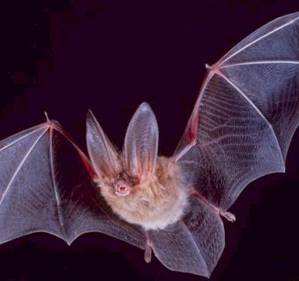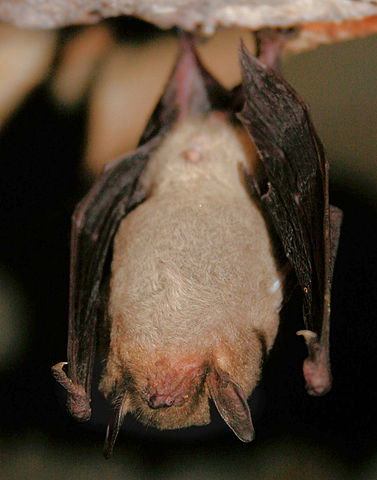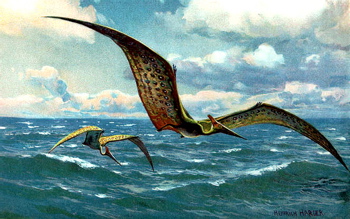On the Origins of New Forms of Life
9.6: Bats
EUGENE M. MCCARTHY, PHD GENETICS
|
|
(Continued from the previous page)

|
| Corynorhinus townsendii Image: Geanixx |

|
| Myotis grisescens |
Among mammals, more forms treated as species are included in the order Chiroptera (bats) than in any other, with the exception of Order Rodentia. Nowak (1999: 259) says there are 977 such forms. Like that of rodents, the origin of bats is a mystery. As is the case with birds, their fossils are rarely preserved due to their delicate bone structure. In the entire fossil record, complete bat fossils are known from only two locations, both of Eocene age, the Messel shales of Germany and the Green River Formation of southwestern Wyoming (U.S.). These ancient bats, which are relatively common within these two fifty-million-year-old formations, are very similar to modern bats. From earlier deposits only teeth are known. Fruit bats, which are largely restricted to tropical environments unconducive to fossil formation, are known from just two partial skeletons (of Oligocene and Miocene age). The rapid and early amplification of bats has long perplexed biologists; no ancestral forms are recognized. Habersetzer et al. (1992) assert that the finding that the earliest known bat fossils are fully evolved suggests the actual origin of bats took place at a far earlier date.
Bats puzzled Darwin, too. He could not think what lifestyle would bring about gradual selection for wings. In referring to "half-winged bats," Darwin said, "It is not possible to imagine what habits an animal could have had with such a structure." The most widely accepted theory of bat origins says bats are descended, once again, from a "small, primitive, generalized" insectivore living late in the Cretaceous Period. This insectivore supposedly spent its time searching for insects in trees. When done with one tree, it would descend and go to another. Wings, it is said, evolved to aid these animals in getting from tree to tree, first by gliding, then by flapping. Ultimately, as the story goes, early bats stopped searching for bugs in trees and came to feed on airborne insects. Their descendants then supposedly went on to diversify into a variety of forms, most feeding on insects, but others eating fruit, nectar, blood, flesh, fish, or even pollen.
But fossil evidence substantiating this story is lacking. The earliest recognized bats are not "half-bats." They are fully developed. The accepted explanation of bat origins also ignores the fact that a type of animal much more similar to bats than the typical terrestrial or arboreal insectivore is known to have existed throughout much of the Mesozoic, prior to the advent of bats. A large variety of forms existed in this category. Some had the wingspan of a sparrow; others, that of a small airplane. These animals had naked wings, and some forms, at least, are known to have had hairy bodies. In many, the flight membranes not only connected with the sides of the body, but also incorporated the hind legs and tail—again, as in bats. Analysis of the hind limb anatomy suggests these animals hung upside down when not in flight. We know they varied in lifestyle as well, because the teeth of different forms were suited to the consumption of different types of foods. The idea that they were warm-blooded is now generally accepted.

|
| Artist's rendering of Pteranodon, one of the largest pterosaurs. (Painter: Heinrich Harder) |
As the reader may have guessed, the type of creature in question is the pterosaur. But pterosaurs (long known as pterodactyls) have not been proposed as bat ancestors, perhaps because the idea that they are something other than reptiles has not been widely considered until recent years. Nevertheless—however pterosaurs have been classified—certain of these animals, (such as the small, insectivorous, short-headed, hairy, warm-blooded Sordes pilosus, were quite batlike. Indeed, fossil remains clearly show that Sordes had thick fur and, on this basis, Wellnhofer (1991: 102) draws a general conclusion about so-called flying reptiles:
Also similar were such forms such as Anurognathus, Batrachognathus, and Scaphognathus. These three latter types are known only from the late Jurassic and thus long predate the first acknowledged fossil bats. But the fossils of some small forms described as pterosaurs are known from the late Cretaceous. Even in late Jurassic strata, the remains of small pterosaurs are relatively rare, perhaps because the small, delicate bones of these animals were rarely preserved. The 50- or 60-million year period intervening between the late Jurassic and late Cretaceous is a gap in the terrestrial fossil record in which even large, durable bones have not been preserved, let alone those of bats and pterosaurs. It is more reasonable to suppose modern bats are descended from these similar precursor forms than from a generalized shrew. This is true despite the fact that, unlike bats, most pterosaurs supported the wing with a single finger. In bats, typically, all digits but one are involved in supporting the wing. A relatively minor difference such as this, however, seems much easier to overcome than that between bats and the entirely wingless, shrewlike ancestor proposed for bats by orthodox theory. In fact, mutations resulting in digital fusion by means of soft tissue webbing are fairly common. They affect aberrant individuals in a variety of mammals, including humans. Perhaps, too, there was variation in pterosaurs with respect to this trait so that some types supported the wing with more digits than did others.
In addition to bats and ancient pterosaurs, various types of living mammals have skin flaps running between the fore and hind limbs and are capable of gliding, although they lack the skeletal characteristics of bats. Included in this category are the flying squirrels (Aeromys, Glaucomys, Hylopetes, Petaurista, Petinomys, Pteromys, and the anomalurids), the flying lemurs (Dermoptera), and the gliding possums (Acrobates, Petaurus, and Shoinobates). All of these animals are nocturnal and, like bats, hide away in dark hollows and crevices by day. Typically, they consume fruits, nuts, nectar, insects, and small vertebrates. Flying lemurs, however, seem to restrict themselves to fruits and vegetable matter. They are not known to consume insects or vertebrates. Unlike flying squirrels, flying lemurs hang upside-down from branches when not in flight. They are quite large and their forebears might plausibly be connected with the ancestors of the large Old World fruit bats (Megachiroptera). Gliding mammals are known from the Paleocene, the very earliest epoch of the "Age of Mammals." Inasmuch as their skeletal remains are like those of other wingless mammals, even earlier fossils, such as those of certain multituberculate/rodents, could easily represent such animals. The ancestors of animals of this type, then, may have anciently participated in a similarity chain connected to pterosaurs that eventually gave rise to the similarity chain composed of modern bats.
8.1: Dubious Assumptions - © Macroevolution.net